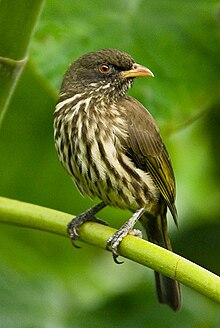
The piapiac is an African bird in the crow family, and is the only member of the genus Ptilostomus. It is most closely related to the Central Asian ground jays.
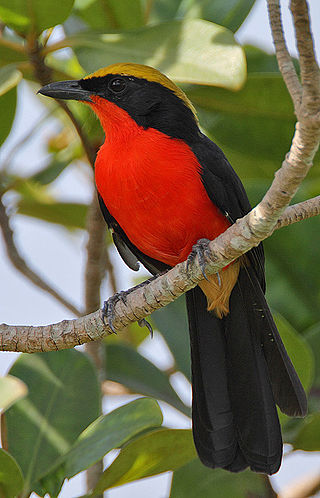
The yellow-crowned gonolek, also known as the common gonolek, is a medium-sized passerine bird in the bushshrike family. It is a common resident breeding bird in equatorial Africa from Senegal and Democratic Republic of Congo east to Ethiopia. It is a skulking bird and frequents dense undergrowth in forests and other wooded habitats. The nest is a cup structure in a bush or tree in which two eggs are laid.
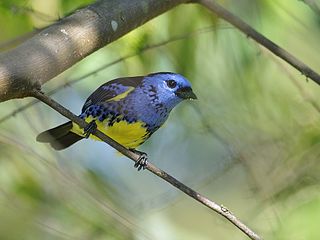
The turquoise tanager is a medium-sized passerine bird in the tanager family Thraupidae. It is a resident bird from Trinidad, much of Brazil, Colombia and Venezuela south to Bolivia. It is restricted to areas with humid forest, with its primary distribution being the Amazon. It was formerly treated as being conspecific with the white-bellied tanager which is found in the Atlantic Forest of eastern Brazil.

The bay-headed tanager is a medium-sized passerine bird. This tanager is a resident breeder in Costa Rica, Panama, South America south to Ecuador, Bolivia and north-western Brazil, and on Trinidad.

The gray kingbird or grey kingbird, also known as pitirre, petchary or white-breasted kingbird, is a passerine bird in the tyrant flycatchers family Tyrannidae. The species was first described on the island of Hispaniola, then called Santo Domingo, thus the dominicensis name.

The black-tailed tityra is a medium-sized passerine bird of tropical South America. The tityras have been placed in the cotinga or the tyrant flycatcher families by various authors. But the weight of evidence strongly suggest they and their closest relatives are better separated as Tityridae; the AOU for example advocates this separation.

The hair-crested drongo is an Asian bird of the family Dicruridae. This species was formerly considered conspecific with Dicrurus bracteatus, for which the name "spangled drongo" – formerly used for both – is now usually reserved. Some authorities include the Sumatran drongo in D. hottentottus as subspecies.

The Hispaniolan mango is a species of hummingbird in the subfamily Polytminae. It is endemic to the Caribbean island of Hispaniola.
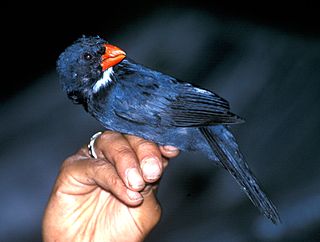
The slate-coloured grosbeak is a species of grosbeak in the family Thraupidae. Most of its range is the Amazon in South America, but it is also found in forests of the Chocó in Ecuador and Colombia, and southern Central America from Panama to Honduras.
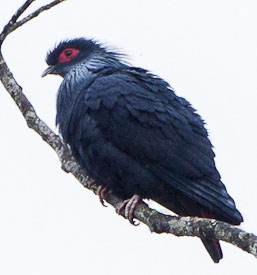
The Madagascar blue pigeon or Madagascan blue pigeon is a species of bird in the family Columbidae. The species is closely related to the other two extant species of blue pigeon, the Comoros blue pigeon and the Seychelles blue pigeon. It is endemic to northern and eastern Madagascar.
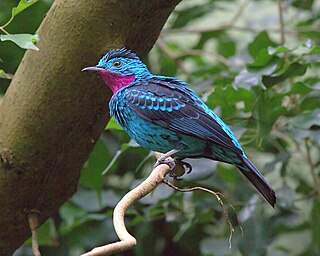
The spangled cotinga is a species of bird in the family Cotingidae, the cotingas. It is found in the canopy of the Amazon Rainforest in South America.

The plum-throated cotinga is a species of bird in the family Cotingidae. It is found in Bolivia, Brazil, Colombia, Ecuador, and Peru. Its natural habitats are subtropical or tropical moist lowland forest, subtropical or tropical swamps, and heavily degraded former forest.

The balicassiao is a species of passerine bird in the family Dicruridae. It is endemic to the Philippines.

The golden-sided euphonia is a species of bird in the family Fringillidae. It is found in northern Brazil, French Guiana, Guyana, Suriname and eastern Venezuela. Its natural habitat is subtropical or tropical moist lowland forest.
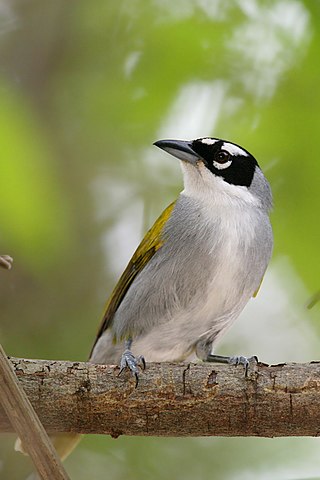
The black-crowned palm-tanager or black-crowned tanager is a species of bird of the family Phaenicophilidae, the Hispaniolan palm-tanagers. It is endemic to the island of Hispaniola which is shared by Haiti and the Dominican Republic.

The fulvous-crested tanager is a species of bird in the family Thraupidae, the tanagers.

The opal-rumped tanager is a species of bird in the family Thraupidae. It is found in the Amazon and Atlantic Forest of South America. The population of the Atlantic Forest has a far paler chest than the other populations, and has often been considered a separate species as the silvery-breasted tanager. Today most authorities treat it as a subspecies of the opal-rumped tanager.

The hook-billed vanga is a species of bird in the family Vangidae. It is endemic to Madagascar. Its natural habitats are subtropical or tropical dry forest, subtropical or tropical moist lowland forest, and subtropical or tropical moist montane forest.
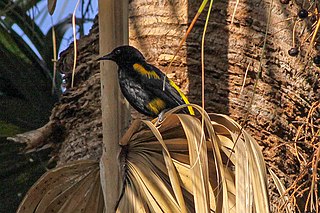
The Hispaniolan oriole is a species of bird in the family Icteridae. It is endemic to the Caribbean island of Hispaniola.

The white-bellied tanager is a medium-sized passerine bird in the tanager family Thraupidae. It is a resident bird of the Atlantic Forest of eastern Brazil. It is restricted to areas with humid forest. It was formerly considered as a subspecies of the turquoise tanager.
